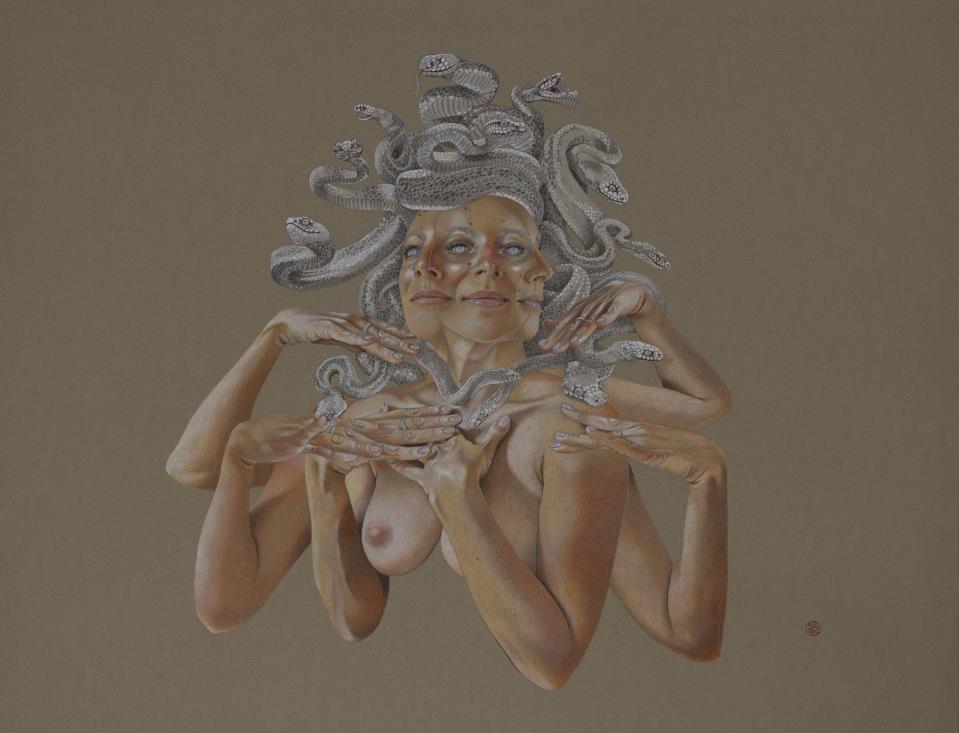Jessica DeMers, an American artist now based in Malta, has been a dynamic presence in the art world for many years. Her career spans roles as a gallery director, art teacher, and member of the Young Women's Caucus. Throughout her journey, she has also earned numerous awards, grants, and scholarships.
In "Gods & Monsters", Jessica's focus on the human face and hands takes center stage. These elements, central to her artistic expression, explore themes of connection and emotion, making this exhibition a striking showcase of her talent.

The works delve into the characters of Greek mythology, challenging our perceptions of gods and monsters within these ancient tales. The word "mythology" derives from the Greek muthos (story) and logia (knowledge), encapsulating the role of myths as bridges between the human realm and the divine. Myths bring structure to chaos, laying the groundwork for religion and culture while offering insights into the human experience.
In this exhibition, Jessica DeMers explores the fragility of the all-powerful gods and searches for traces of goodness within the monstrosity of certain mythological figures. By unraveling the complexities of their characters and the tragedies that often define their origins, she reveals their humanity.

Through these narratives, DeMers invites us to reflect on the parallels between these mythological beings and the characters in our own lives, urging us to find echoes of their stories in the modern world.
I had the privilege of being part of Jessica DeMers' journey for "Gods & Monsters" from an early stage-an experience that resulted in one of the exhibition's works. During one of our meetings, Jessica shared the concept she was working around, and I had just finished reading Circe by Madeline Miller. The novel's perspective seemed to align perfectly with the themes Jessica was exploring. Intrigued, she immediately read it.

Since I suggested the book and I am also the exhibition's curator, a few weeks later I found myself posing for Jessica and she immortalized me as Circe! So as sometimes happens... ego first, I'll start with the stunning depiction of me as the famously infamous enchantress, titled, I'll Show You Who I Am (& Who You Are). A web of hand gestures, delicately creating curves in mid-air, while concocting a potion-perhaps a love potion-in a champagne saucer kind of glass (my kind of glass), with her eyes closed, but a mystical third eye wide open, an all-seeing magical eye. The surreal composition continues with another playful web created with Circe's hair and touches of golden glittery specs which are floating and dancing on top of the chalice.
Another standout piece, one of the largest works in the exhibition, is Fate, an evocative oil painting on canvas. It presents three female figures embodying the three ages of Man, nude against a stark black background. This deeply personal work emerged during a challenging period in Jessica's life when she faced the uncertainty of a potentially life-threatening illness.

Through Fate, she reflects on the fragility and brevity of life, reminding us of its preciousness. The Fates, often seen as cruel in their act of cutting the thread of life short, are reimagined here as impartial figures, embodying the natural laws of existence rather than mercy or malice. A glowing thread of life runs through the painting, with the eldest Fate poised to cut it with scissors in hand, at an 'earlier' stage than one hopes. The surreal, luminous quality of the thread draws the viewer's eye, serving as a poignant reminder of life's delicate balance and fragility.
Another captivating painting, This Might As Well Not Be Real, centers on Dionysus, the god of wine and pleasure. The work explores the blurred boundaries between indulgence and solitude, symbolizing a life consumed by excess. The painting's triple face and overlapping facial features artfully convey the disorientation of intoxication, with the sensation of "seeing double" rendered beautifully. Beneath the surface, however, the piece suggests a poignant truth: the relentless pursuit of pleasure often masks a deeper longing for genuine connection.
Two striking works in the exhibition depict the iconic Medusa, each from a unique perspective. In Medusa: Peace After Wrongful Conviction, she is almost smiling, exuding pride and strength. DeMers portrays her as monumental, capturing her face from three distinct angles in a single, harmonious stance-a vision of empowerment and reclamation.

Conversely, Medusa: The Final Moment presents a more haunting vision. Here, Medusa is in a state of containment, her head and chest encircled by hands while her snakes writhe upward, as if seeking escape. Her piercing gaze is intensified by five eyes aligned in a straight line, echoing a heartbeat's final flatline. This chilling composition conveys both finality and the inescapable power of her infamous stare.
The largest painting in the collection, Siren's Call, merges Maltese culture with mythological lore. DeMers incorporates the iconic Maltese luzzu into a tempestuous scene, where two sirens lure a fisherman toward the ocean's depths. Their haunting song is amplified by the drama of a massive wave, illuminated by the glow of a full moon, pulling the viewer into a vortex of danger and desire.

In Pandora's Hope, DeMers reimagines the tale of Pandora in a moment of profound despair. Set against a pitch-black background, the painting initially appears dotted with glowing red lights. Upon closer inspection, these are revealed as the eyes of countless skulls, symbolizing the evils unleashed from Pandora's box, spreading to the farthest corners of the earth. Amid this chaos, Pandora cradles a small, luminous glow in her hands-the fragile yet enduring essence of hope, the one thing left to humanity after all else was lost.
DeMers is also experimenting with sculpture and one of the three sculptures making part of this exhibition, titled The Offering captures the moment Hades offers the seed to Persephone-an act that binds her to the Underworld. It's an unclear situation as to whether or not Persephone was deceived, or if it was her own choice to willingly eat the seed to embrace her duality as both goddess of spring and queen of the dead. Did she 'bite' more than she was bargaining for? We will never know.
In this exhibition, DeMers encourages us to reflect deeply on these mythological figures, urging us to empathize and seek the beauty and goodness within, even in those initially perceived as monstrous. By peeling back the layers, she challenges us to explore the blurred boundaries between heroism and monstrosity, light and dark-reminding us that reality often exists within these gray areas.
Jessica DeMers' work has been showcased internationally, with exhibitions held in the USA, Japan, China, England, and most recently in Malta.
'Gods & Monsters' is on till 29 December at il-Kamra ta' Fuq, Mqabba.